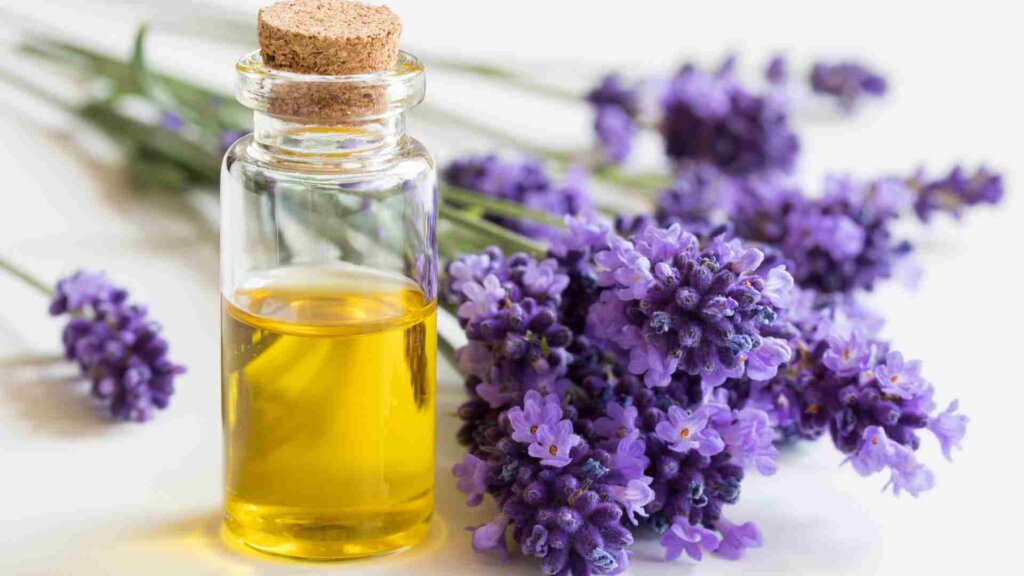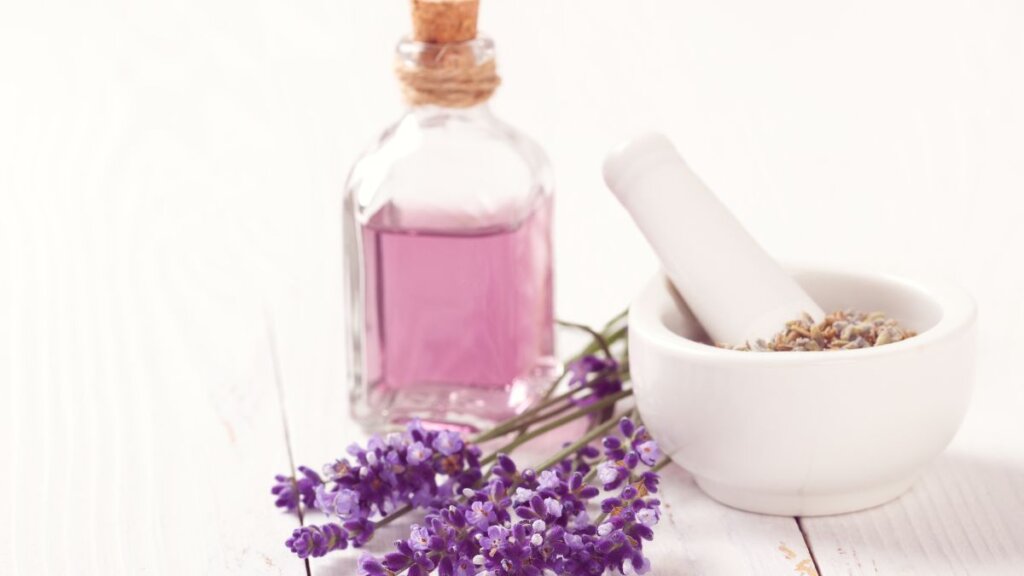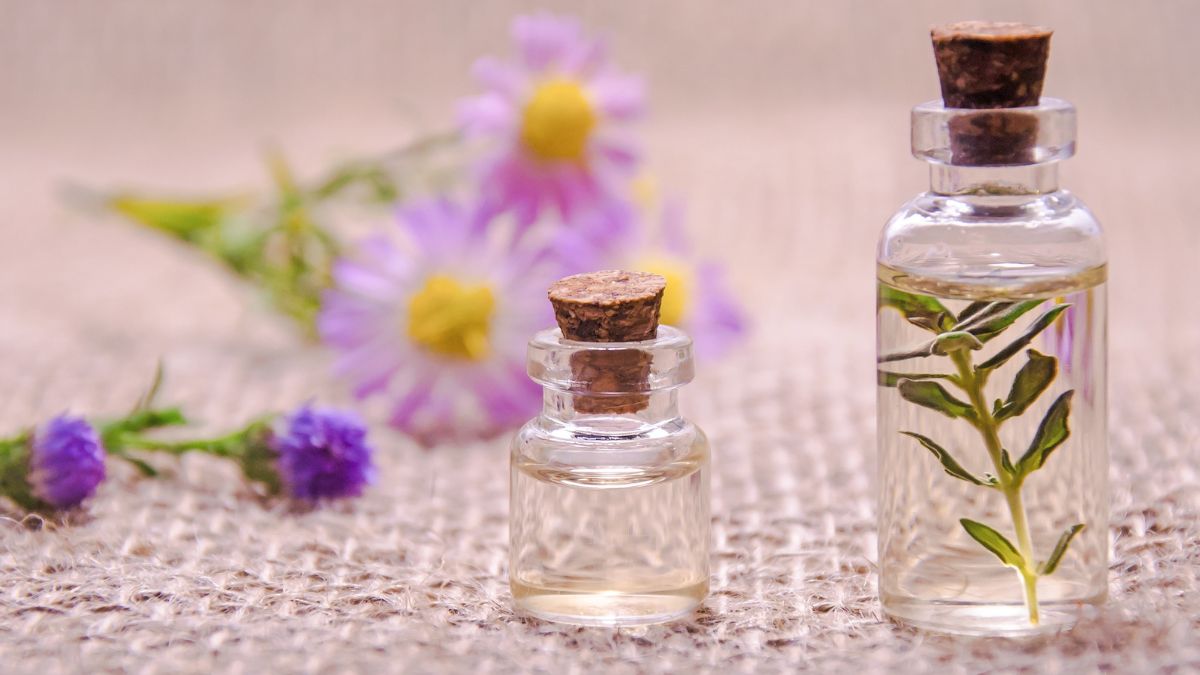Lavender essential oil is one of the best-known oils in aromatherapy. Its soft, floral scent has been used for centuries to calm the mind, ease stress, and bring balance.
Today it remains among the most popular essential oils, valued both for its fragrance and its many everyday uses. It’s also a great choice for beginners, safe when used correctly, and blends well with a wide range of other oils.
What Is Lavender Essential Oil?

Lavender essential oil comes from the flowering tops of the lavender plant (Lavandula angustifolia). It is usually made through steam distillation, a gentle process that preserves both the fragrance and the active compounds. Two of the most studied are linalool and linalyl acetate, which are linked to lavender’s relaxing effects.
Unlike fragrance oils, which are made in laboratories to provide scent only, lavender essential oil is a pure plant extract. This means it carries not just a pleasant aroma, but also natural properties that support wellbeing.
The result is a sweet, floral essence with a fresh herbal note — a fragrance that explains why lavender remains one of the most widely used oils worldwide.
If you want to know how essential oils differ from fragrance oils, look at my guide: Fragrance Oil vs Essential Oil: What’s the Difference and Which Should You Use?
Benefits of Lavender Essential Oil
Sleep and Relaxation
Lavender essential oil is often chosen as a natural support for better sleep. For centuries, people have added its fragrance to pillows, baths, and bedtime blends, and modern research now backs up these long-standing practices.
A systematic review of 11 clinical trials found that inhaling lavender oil was linked with improved sleep quality. The benefits were strongest when lavender was used for at least two weeks and when the aroma was kept close to the pillow at night. Other studies also suggest lavender can increase time spent in deep, restorative rest.
By calming the nervous system, lavender helps the body release tension and slip more easily into sleep. For those struggling with restless nights, it offers a gentle, non-invasive option supported by both tradition and science.
Stress and Anxiety
Lavender has also been studied for its ability to ease stress and anxiety during the day. Research shows that inhaling the aroma can lower certain biological markers of stress and support a more balanced mood. Clinical trials suggest that regular use may reduce anxiety symptoms and improve overall wellbeing.
Unlike many calming remedies, lavender doesn’t cause drowsiness. This makes it useful in situations where calm and focus are both needed, such as work, study, or public speaking. It has also been explored as a complementary therapy in clinical settings where patients often experience high stress.
Headache and Pain Relief
Lavender essential oil is sometimes explored as a complementary option for headaches and mild pain. While it isn’t a substitute for medical care, studies suggest it can bring comfort during painful moments.
In one clinical trial, people who inhaled lavender during a migraine attack reported a significant drop in headache severity. Another study with patients suffering from post-dural puncture headaches (a severe pain that can follow spinal procedures) found that short-term lavender inhalation gave greater relief.
Wider reviews of aromatherapy also point to possible benefits, suggesting that essential oils, including lavender, may help ease certain types of pain when used alongside standard treatment.
Skin, Hair and Scalp
Lavender essential oil has also been studied for its effects on skin and scalp health. While much of the research is still experimental, findings suggest that it may support the body’s natural repair processes and help calm irritation.
Laboratory studies have shown that wounds treated with lavender oil closed more quickly, formed healthier collagen, and showed less inflammation compared with untreated wounds. Another study using a blend of lavender and other herbal extracts reported stronger antioxidant activity and faster recovery in damaged skin.
There is also some early evidence for effects on hair growth. In one experiment with mice, regular application of lavender oil increased the number of hair follicles and improved scalp condition over several weeks.
Although most studies so far are based on animal or laboratory models, they point to lavender’s natural compounds as possible aids in tissue repair and skin soothing.
Insect Repellent and Cleaning
Lavender essential oil has been used for centuries to freshen homes and keep pests away. Today, studies suggest it can also slow the growth of certain microbes, including E. coli and make some antibiotics work more effectively.
While it should never replace strong cleaners, adding lavender to a homemade spray can make it more effective while leaving the air smelling fresh.
Lavender has also been tested as a gentle insect repellent. Research shows it can help keep mosquitoes and moths away, though its effects don’t last as long as commercial sprays. Even so, it’s still a popular natural choice. Many people use lavender sachets in wardrobes or light sprays outdoors on summer evenings.
As its protective power fades, lavender leaves behind a light, soothing scent.
What Does Lavender Essential Oil Blend Well With?

Lavender mixes easily with many essential oils, which is one reason it appears in so many blends. Here are a few combinations that work well for different moods and purposes:
- Chamomile – A classic match for relaxation. Together they help create a peaceful atmosphere and support a better night’s sleep.
- Peppermint – The crisp, cooling scent of peppermint balances lavender’s warmth. This blend works well when you need to clear your head or ease tension.
- Frankincense – Earthy and grounding, frankincense adds depth to lavender. It’s often used in blends that encourage focus, meditation, or reflection.
- Citrus oils (orange, lemon, bergamot) – These add brightness and energy. When paired with lavender, the result is an uplifting scent that feels clean and fresh without being overpowering.
- Rosemary – This crisp, herbal oil balances lavender’s softness and works well in blends that sharpen focus or freshen up a room.
How to Use Lavender Essential Oil
There are many ways to use lavender oil in your daily routines. Here are some of the most popular:
- Diffusion – Add 3–5 drops to your diffuser with water. The scent fills the air and helps create a more restful atmosphere.
- Topical use – Always dilute in a carrier oil such as almond, jojoba, or coconut. A common guide is 6–12 drops in 30 ml of carrier oil. This can be massaged into the skin or applied to areas of tension.
- Baths – Mix 5–8 drops with a tablespoon of carrier oil or Epsom salts before adding to warm water. This helps the oil spread evenly in the bath. It may not sound like much, but that’s enough to scent the bath gently while keeping your skin comfortable.
- Pillow and linen sprays – Combine lavender with water and a small splash of witch hazel in a spray bottle. If you prefer, add a tiny amount of clear alcohol (such as vodka) to help the oil disperse. Don’t worry – the scent fades quickly as it dries. Shake well, then lightly mist over bedding before sleep for a relaxing aroma.
- Home cleaning – Add to DIY sprays with lemon, tea tree, or eucalyptus oils. This freshens the air and leaves a natural scent behind.
Safety and Precautions When Using Lavender Essential Oil

Lavender oil is considered one of the gentler essential oils, but it still needs to be used with care. A few simple guidelines can help you use it safely:
- Dilution and patch testing – Always mix lavender oil with a carrier oil before putting it on the skin. A 1–2% dilution (about 6–12 drops in 30 ml of carrier oil) is a safe guide. If you have sensitive skin, test a small area first. Keep bottles stored in dark glass, away from heat and light.
- Children – Lavender is sometimes used with children, but there have been rare reports of hormonal effects in young boys with frequent use. To be cautious, only use well-diluted blends and avoid daily, long-term application.
- Pregnancy and breastfeeding – Many practitioners advise avoiding essential oils in the first trimester. Later in pregnancy, lavender is often considered one of the safer options, but keep blends very mild and check with a healthcare professional if you’re unsure.
- Pets – Diffuse in well-ventilated rooms and let pets leave if they want to. Dogs may tolerate lavender in small amounts, but cats are more sensitive and often do not. Never apply essential oils directly to pets or allow them to ingest them.
- Internal use – Do not take lavender oil internally unless under the guidance of a qualified professional. Specially prepared oral capsules are different from the oils sold for home use.
How Do You Make Lavender Essential Oil
One of the most common questions I hear is whether it’s possible to make lavender essential oil at home. The truth is that real essential oil needs steam distillation. This process requires a lot of flowers and specialised equipment – not something most of us have in the kitchen.
What you can make at home, however, is a lavender-infused oil. While not as concentrated as essential oil, it still carries the flower’s gentle fragrance and many of its soothing qualities.
To do this, simply cover dried lavender buds with a carrier oil (such as almond, jojoba, or olive) in a sealed jar. Leave it in a warm place for 2–4 weeks, then strain and store the oil in a dark glass bottle.
It won’t have the strength of distilled essential oil, but it’s an easy, natural way to enjoy lavender in DIY skincare or massage blends.
For a step-by-step guide, including different methods, see my article: [How to Make Lavender Oil].
Final Thoughts
There’s a reason lavender essential oil is found in so many homes and has earned its place as one of the most loved natural oils. It supports better sleep, eases stress and tension, and leaves the house fresh.
I often recommend it as a starting point for anyone new to essential oils, because it’s safe when used correctly and blends well with others.
I hope you enjoyed this article and found it helpful. If you’d like to learn more about essential oils and simple ways to use them, come back soon for new tips and inspiration from The Nature’s Magic Hub.
Lavender Essential Oil FAQ

What is lavender essential oil good for?
Lavender essential oil is most often used for relaxation, better sleep, easing stress, and creating a calmer mood. Research also suggests it may help with headaches, mild pain, and supporting skin repair. Many people use it in diffusers, pillow sprays, and massage blends for its soothing effects.
What does lavender essential oil do to the brain?
Studies suggest that inhaling lavender essential oil can calm the nervous system and influence brain activity linked with relaxation. Compounds such as linalool may reduce stress markers and promote a sense of calm, which explains why lavender is often used for sleep and anxiety.
What is the best essential oil to mix with lavender?
Lavender blends well with many oils. For relaxation, try chamomile, for focus, pair it with rosemary or peppermint, and for uplifting moods, citrus oils like orange or lemon are excellent partners. Frankincense also adds a grounding depth that balances lavender beautifully.
How to know if a lavender essential oil is pure?
Check the label for the botanical name Lavandula angustifolia. Pure oils should list only the plant extract, without added fragrance or fillers. Choose brands that provide GC-MS (Gas Chromatography–Mass Spectrometry) reports, which show the oil’s chemical profile. A true lavender oil will often highlight its main compounds, linalool and linalyl acetate.
Which type of lavender essential oil is best?
The most widely recommended type is Lavandula angustifolia (also called English lavender or true lavender). It is gentle, versatile, and well suited for relaxation, sleep, and skincare. Other varieties, such as Lavandula latifolia (spike lavender), have different properties and stronger camphor notes, making them more suitable for respiratory blends.
Is lavender essential oil safe?
Lavender essential oil is considered one of the gentlest oils when used correctly. However, safety depends on proper dilution, storage, and use. It should be avoided in the first trimester of pregnancy, used with caution around children, and never ingested unless prescribed in capsule form by a healthcare professional.
Can I put pure lavender essential oil on my skin?
It is not advised to apply pure lavender essential oil directly to the skin. Always dilute it in a carrier oil, such as almond or jojoba, before use. A 1–2% dilution (6–12 drops of essential oil per 30 ml of carrier oil) is generally safe. This reduces the risk of irritation and allows the oil to be absorbed more gently.
When not to use lavender essential oil?
Avoid lavender essential oil if you have known allergies to lavender or experience skin irritation after patch testing. It is best not to use essential oils in the first trimester of pregnancy. Lavender should not be applied directly to pets, and diffusion around cats should be done with caution. Always dilute before applying to skin and do not take lavender oil internally unless under professional guidance.
How to make lavender essential oil?
True lavender essential oil is produced through steam distillation, which requires large amounts of flowers and professional equipment. At home, you can make a lavender-infused oil instead by covering dried lavender buds with a carrier oil and letting it infuse for several weeks. This will not be as concentrated as distilled essential oil, but it carries a gentle fragrance and is easy to use in DIY recipes.
Do essential oils expire?
Yes. Essential oils gradually lose their potency and can oxidise over time. Lavender essential oil usually lasts around 3–4 years if stored in a cool, dark place in a tightly sealed glass bottle. If the scent changes noticeably or the oil irritates your skin, it is time to replace it.
If you enjoyed this article, feel free to share it with your friends and family to spread the knowledge!
Don’t forget to follow us on social media for more tips, updates, and insights into natural remedies and holistic wellness.
Join our community and stay connected to discover the magic of nature for a healthier, happier life!

